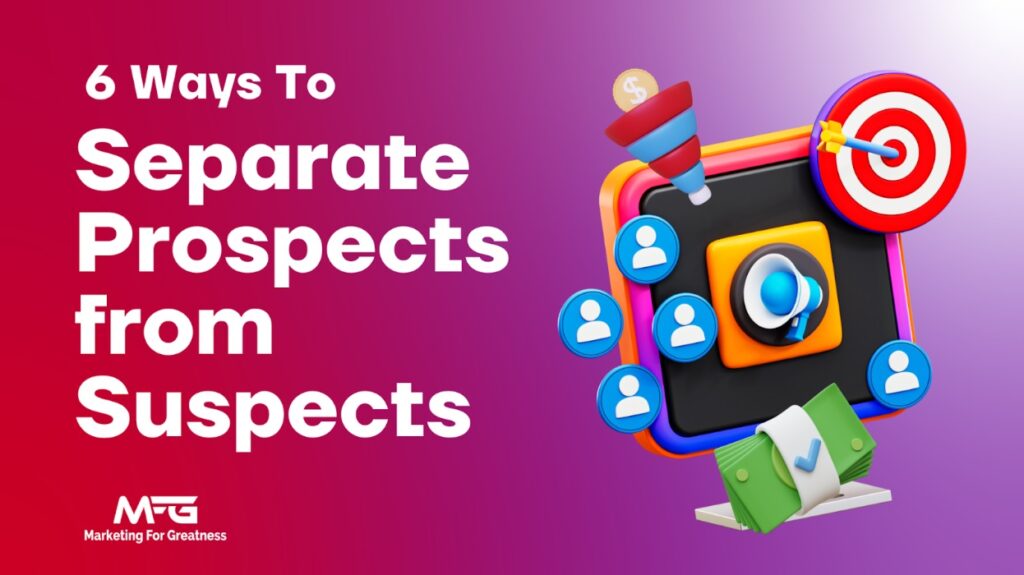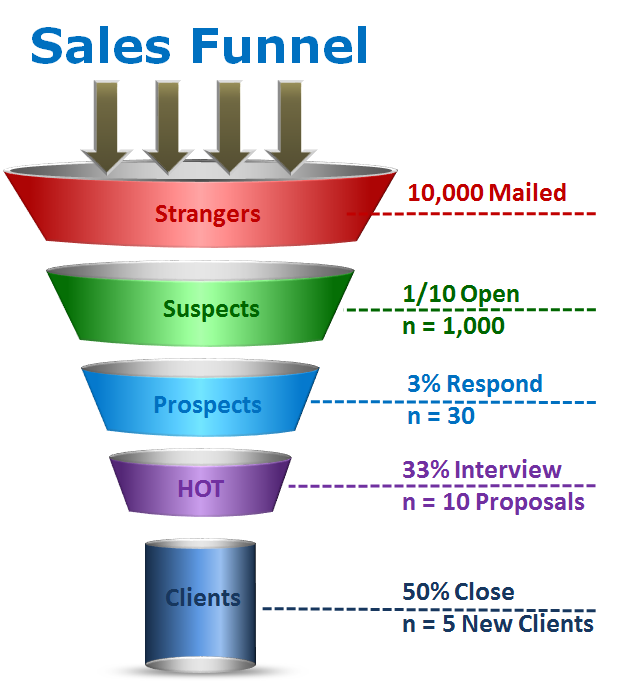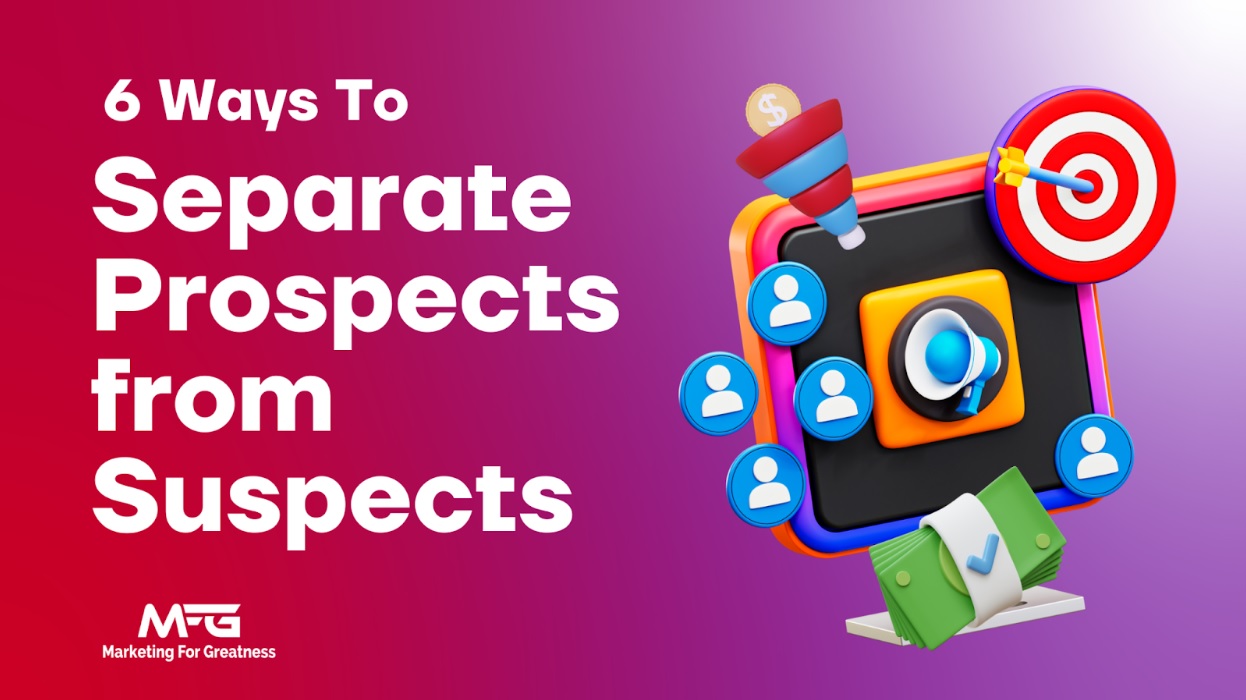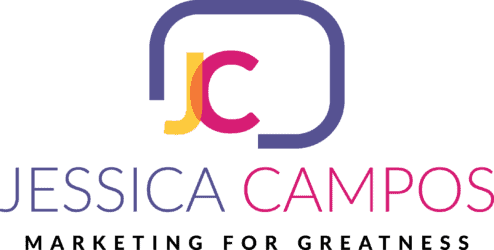- February 24, 2023
- 3:08 am
6 Ways to Separate Prospects from Suspects

Hey there! Jessica here from Marketing for Greatness, and today we’re talking about one of the biggest challenges in marketing: separating prospects from suspects. As a business owner or marketer, it’s essential to make sure that you’re targeting the right people with your marketing efforts. In this article, we’re going to give you six effective ways to separate prospects from suspects.
But First Things First: What is a Prospect vs a Lead?
Before we dive into the strategies to turn your suspects into prospects, we need to define some fundamental terms, starting with a lead.
What is a lead?
Simply put, a lead is a potential customer who has expressed interest in your product or service. However, not all leads are created equal. Some are more valuable than others, and it’s important to understand the different types of leads so you can target them effectively.
There are several different types of leads, including:
- Marketing leads: These are leads that have shown interest in your brand or products through various marketing channels, such as social media, email, or online ads. They are usually at the top of the sales funnel and are not yet ready to make a purchase.
- Sales leads: These are leads that have been qualified as potential customers and are actively considering making a purchase. They are closer to the bottom of the sales funnel and require more targeted messaging and sales tactics to convert them into customers.
- Qualified leads: These are leads that have been evaluated and deemed as potential customers based on specific criteria, such as their demographics, behavior, or level of interest. They are more likely to convert into paying customers and are valuable assets to any business. Qualified leads are also known by prospects.
Now that we’ve defined what a lead is, let’s dive into the differences between marketing leads and sales leads.
What is a marketing lead?
Marketing leads are potential customers who have shown interest in your brand or products through various marketing channels. They may have engaged with your social media posts, subscribed to your email list, or clicked on an online ad. They are usually at the top of the sales funnel and are not yet ready to make a purchase. Marketing leads are important because they provide potential customers that can be nurtured and converted into sales leads.
Examples of marketing leads include:
- Social media followers who engage with your content
- Email subscribers who have opened or clicked on your emails
- Website visitors who have downloaded a free resource or signed up for a newsletter
What is the difference between marketing leads and sales leads?
The main difference about marketing and sales leads has to do with where their mind is at. Sales leads are actively considering making a purchase. They are closer to the bottom of the sales funnel and require more targeted messaging and sales tactics to convert them into customers.
Examples of sales leads include:
- Prospective customers who have requested a demo or a consultation
- Website visitors who have added items to their cart or expressed interest in pricing
- Leads who have attended a sales webinar or event
Marketing Leads vs Sales Leads: Who Handles What?
When it comes to handling marketing and sales leads, it’s important to have a clear understanding of which teams are responsible for each type of lead.
Marketing teams are typically responsible for generating marketing leads, which are the initial contacts made through marketing efforts. This includes lead capture forms on websites, social media engagement, and email marketing campaigns. The goal of marketing leads is to generate interest and create a pipeline of potential customers.
On the other hand, sales teams are responsible for handling sales leads, which are qualified leads that have shown a higher level of interest and are more likely to convert into paying customers. This includes leads that have expressed a direct interest in your product or service, engaged with your sales team, or have requested more information about your business.
In some cases, there may be overlap between the responsibilities of marketing and sales teams. For example, marketing teams may be responsible for lead nurturing campaigns that help move marketing leads down the sales funnel and qualify them as sales leads. Sales teams may also provide feedback to the marketing team about the quality of leads generated by marketing efforts.
Ultimately, the key is to have clear communication and collaboration between marketing and sales teams to ensure a seamless transition from marketing leads to sales leads. By working together, these teams can help increase lead conversion rates and drive revenue growth for the business.
It’s important to note that while your marketing team can be great at generating suspects and marketing leads, if the business doesn’t have a strategic sales process in place, sales won’t happen. It’s essential to have a clear understanding of the sales funnel and how leads move through it. This includes having a system for qualifying leads, nurturing relationships, and closing deals. Without a strategic sales process, even the most qualified leads may fall through the cracks, resulting in lost revenue for the business. By having a well-defined sales process in place, businesses can ensure that marketing leads are effectively converted into sales leads, ultimately leading to increased revenue and business growth.
We’ve covered everything about leads. Now let’s dive into prospects.
Lead vs Prospect: What’s the Difference?
A lead is a potential customer who has expressed interest in your product or service, whereas a prospect is a potential customer who has shown a higher level of interest and is more likely to become a paying customer. In other words, a prospect is a qualified lead that has been evaluated and deemed as having a higher potential to convert into a sale.
Let’s say you run an online clothing store. A lead may be someone who has subscribed to your email list in order to receive updates and promotions from your store. This person has expressed some level of interest in your products, but may not be actively considering a purchase at the moment.
In contrast, a prospect may be someone who has added items to their cart or clicked on a specific product page multiple times. This person has shown a higher level of interest in your products and may be closer to making a purchase.
By distinguishing between leads and prospects, you can more effectively target your marketing efforts and focus on those who are most likely to convert into paying customers. In this case, you may want to prioritize marketing efforts towards prospects by retargeting them with ads or offering them a discount to incentivize them to complete their purchase.
To recap: leads are typically at the top of the sales funnel, whereas prospects are further along in the sales funnel and may have engaged with your brand in a more meaningful way.
Prospect vs Suspect: What’s the Difference?
It’s important to note that depending on your sales system, you might use different terms to filter your suspects. But generally speaking, a sales funnel looks like this:

As mentioned previously, prospects are further down the sales funnel and have shown a higher level of interest in your product or service. On the other hand, suspects are potential customers who have not yet expressed a direct interest in your business. These individuals may have interacted with your business in some way, such as visiting your website, following you on social media, or subscribing to your email list, but have not yet taken a clear step towards becoming a paying customer.
Marketing teams typically focus on generating suspects through various marketing channels, such as email marketing, social media advertising, and content marketing. Once these suspects show a higher level of interest, they can be further qualified as sales leads and passed on to the sales team for further follow-up.
By generating suspects through marketing efforts, businesses can create a pipeline of potential customers and increase their chances of converting them into paying customers. However, it’s important to note that not all suspects will ultimately become sales leads, which is why it’s important to have a clear process for qualifying leads and moving them down the sales funnel.
Some characteristics of a prospect include:
- They have a specific problem or need that your product or service can solve.
- They have engaged with your brand through various marketing channels, such as social media, email, or online ads.
- They have shown interest in your product or service by adding items to their cart, filling out a form, or requesting a consultation.
- They fit the profile of your target audience, based on their demographics, behavior, or interests.
In contrast, some characteristics of a suspect include:
- They may have stumbled across your brand but may not necessarily have a specific need for your product or service.
- They have not engaged with your brand in a meaningful way or have shown a limited level of interest.
- They may not fit the profile of your target audience, based on their demographics, behavior, or interests.
A Great Digital Marketing Strategy Should Focus on Increasing Your Suspects, Leads, and Prospects
A great digital marketing strategy should focus on bringing in and nurturing suspects, leads, and prospects in order to increase your chances of converting them into paying customers.
Where to start your lead generation strategy?
Start with your content.
1- Content Marketing SEO
Content Marketing SEO is a marketing strategy that combines the principles of content marketing and search engine optimization (SEO) to improve online visibility, generate traffic, and increase conversions.
At its core, Content Marketing SEO involves creating and sharing valuable and informative content that is optimized for search engines. By targeting specific keywords and search phrases that are relevant to your target audience, businesses can increase their visibility and attract more traffic to their website.
In addition to creating optimized content, Content Marketing SEO also involves building backlinks, improving website structure and technical optimization, and leveraging social media and other channels to promote content and increase engagement.
Ultimately, the goal of content marketing SEO is to improve online visibility, generate high-quality traffic, and increase conversions by providing valuable content that aligns with the needs and preferences of your target audience. This can help you build a larger pool of potential customers to work with and increase the overall success of your digital marketing efforts.
For example, let’s say you run a skincare brand. You may create a blog post that addresses common skincare concerns and offers helpful tips for solving them. By creating content that speaks to your audience’s needs, you can attract new potential customers who are searching for information about skincare and may not have heard of your brand before. Once you’ve attracted these potential customers, you can move them further down your sales funnel by capturing their email and turning them into marketing leads. One effective way to capture their email is by offering a free resource, such as an ebook or a webinar, to incentivize them to take the next step in the sales funnel.
It’s important to note that even if a lead has expressed interest in your brand and provided their email, there is still a chance that your emails may end up in their spam folder, which can lower the chances of conversion. One way to prevent this from happening is to include a confirmation email after a lead has provided their contact information. This email should confirm the subscription and encourage the lead to add your email address to their contact list to avoid future emails going to spam. By taking these steps, you can help ensure that your marketing efforts are more effective and that you are reaching your leads’ inbox.
You might be thinking “suspects are awesome, but they won’t pay my bills!”. And you are right. A great marketing strategy should bring you, not only suspects but also prospects and paying customers. Here’s how.
2- Personalized Emails: Providing Value and Building Relationships
Sending personalized emails to your suspects can be an effective way to build a relationship and demonstrate the value of your product or service. By providing helpful information and addressing their specific needs, you can build trust and encourage them to engage with your brand. This can help move them down the sales funnel and increase the likelihood of conversion.
For example, if you run a fitness coaching business, you may send personalized emails to your suspects that offer workout tips and nutritional advice based on their specific fitness goals. By addressing their needs in a personalized way, you can build trust and demonstrate the value of your coaching services.
3- Social Media: Engaging Your Audience and Encouraging Interaction
Social media can be a powerful tool for engaging your audience and encouraging interaction with your brand. By posting engaging content and responding to comments and messages, you can build a relationship with your suspects and demonstrate your expertise in your field. Then, from your DM’s, engage in private conversations where you can have the chance to get their contact information and get them into a nurturing campaign.
4- Webinars: Providing Value and Demonstrating Expertise
One of the most effective ways to build trust with your audience is to demonstrate your expertise in your field. By providing valuable content that addresses your audience’s needs and establishes your authority, you can position yourself as a leader in your industry and build brand credibility.
Here are some examples of how you can demonstrate expertise:
- Thought Leadership Content: Providing Valuable Insights and Expertise
Thought leadership content can be an effective way to demonstrate your expertise and provide valuable insights to your audience. This can include blog posts, articles, white papers, and other types of content that offer valuable insights and expertise in your field. By providing content that addresses your audience’s needs and establishes your authority, you can build trust and encourage them to engage with your brand.
- Case Studies: Demonstrating Your Successes and Achievements
Case studies can be an effective way to demonstrate your expertise and highlight your successes and achievements. By providing detailed case studies that showcase how your product or service has helped previous clients, you can demonstrate the value of your business and encourage potential customers to engage with your brand.
- Industry Events: Speaking Engagements and Workshops
Participating in industry events such as speaking engagements and workshops can be a powerful way to demonstrate your expertise and build credibility in your field. By offering insights and expertise on relevant topics, you can establish yourself as a thought leader and build brand credibility. This can help attract new potential customers and encourage them to engage with your brand.
- Live Webinars
Webinars can be a powerful way to provide value and demonstrate your expertise in your field. But they need to be done right. According to a report by GoToWebinar, webinars are one of the most effective marketing tactics for generating high-quality leads. The report found that 73% of B2B marketers and sales leaders believe that webinars are the best way to generate high-quality leads. Webinars also offer high engagement rates, with an average attendance rate of 40-50% and an average viewing time of 61 minutes per webinar.
By implementing some of the strategies we’ve discussed, you can generate a substantial number of marketing leads. However, it can be challenging to identify and filter out the true sales leads that are most likely to convert.
So let’s take care of this issue.
6 Ways to Separate Prospects from Suspects
Identifying the most qualified leads is critical to a successful sales and marketing strategy, as it allows businesses to focus their resources and efforts on those leads that are most likely to convert into paying customers. However, depending on the volume of leads and the complexity of the sales process, this can be a daunting task, especially if your business relies on manual lead qualification.
Fortunately, there are many customer relationship management (CRM) software options available that can help streamline the lead qualification process. These tools can automate lead scoring, behavior tracking, and other data analysis tasks, allowing sales and marketing teams to more effectively identify and prioritize leads for follow-up.
If you’re in search of a comprehensive CRM system, we highly recommend Kartra.
Kartra is an all-in-one marketing platform that offers a range of tools and features designed to streamline and optimize your marketing and sales efforts. With Kartra, you can easily create and launch marketing campaigns, manage your leads and customers, and track your sales and revenue performance.
As certified Kartra partners, we offer full integration services that enable you to focus on running your business while we take care of turning your lead generation engine ON! To get started with a free trial, click here.
Your CRM software can also help businesses gain insights into the behaviors and preferences of their leads, providing valuable data to inform their sales and marketing strategies. By using these insights to tailor their outreach efforts, businesses can build stronger relationships with their leads, increase engagement, and ultimately improve their chances of conversion.
Of course, the effectiveness of CRM software depends on the quality and accuracy of the data being input. It’s essential for businesses to ensure that their data is clean, up-to-date, and accurate, to ensure the most effective use of their CRM software. Additionally, it’s important to regularly review and update lead qualification criteria to ensure that they align with current business objectives and customer preferences.
Here are six effective ways to separate prospects from suspects:
- Attribution. Attribution is a data analysis technique that can be used to track and measure the effectiveness of different marketing channels and touchpoints in the customer journey. By assigning credit to each touchpoint in the sales and marketing process, attribution can help businesses identify the most effective channels for generating and nurturing leads, as well as the touchpoints that are most likely to lead to conversions.
- Behavior Tracking: Track the behavior of your leads, such as website visits, email opens, and social media engagement, to identify those who have shown a higher level of interest and engagement.
- Lead Scoring: Use a lead scoring system to evaluate the level of interest and engagement of each lead. This can help identify the most qualified leads and prioritize follow-up efforts.
- Irresistible Offers: To generate sales calls and increase conversions, businesses can offer an irresistible offer to incentivize leads to take action. An irresistible offer is a compelling offer that provides significant value to the lead and motivates them to take the next step in the sales process. Examples of irresistible offers might include a free consultation, a free trial or demo, a limited-time discount or special offer, or access to exclusive content or resources. The key to creating an irresistible offer is to provide a significant value that aligns with the needs and preferences of the lead, while also creating a sense of urgency or exclusivity that motivates them to take action.
- Heat Mapping: Heat mapping tools can help businesses identify which areas of a website receive the most clicks, scrolls, and engagement, allowing them to optimize these areas for maximum effectiveness. By using this data to tailor website content, design, and user experience to the preferences and behaviors of their leads, businesses can increase engagement and ultimately improve their chances of conversion. Heat mapping can also be used to identify areas of a website that are not performing as well, allowing businesses to make improvements and optimizations to improve engagement and conversion rates. For example, if a heat map shows that a certain form field is consistently being skipped over, businesses can adjust the form to make it more user-friendly and increase completion rates.
- Sales Team Feedback: Solicit feedback from your sales team to identify leads that have shown a higher level of interest and engagement. This can help identify the most qualified leads and prioritize follow-up efforts.
By using these strategies to separate prospects from suspects, you can focus your sales and marketing efforts on the most qualified leads and increase your chances of conversion. This can help improve your lead generation efforts and ultimately lead to increased revenue for your business.
In Closing
Separating prospects from suspects is a crucial aspect of a successful sales and marketing strategy. By identifying and engaging the most qualified leads, businesses can increase their chances of conversion and ultimately drive revenue growth.
To improve your lead generation and sales conversion efforts, it’s important to be strategic and intentional in your approach. This includes focusing on the most qualified leads, leveraging advanced tools and technologies, and building trust and loyalty with potential customers.
Shall we talk about your leads?
Wanna chat about your marketing and sales leads? We can provide valuable insights and recommendations to help you optimize your strategy and achieve your sales and marketing goals. Contact us today to learn more and take the first step toward growing your business.


